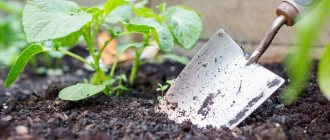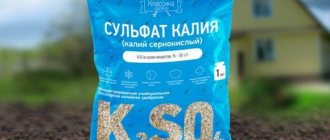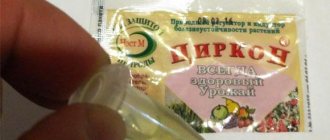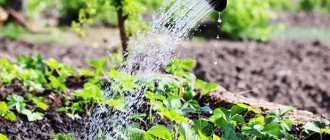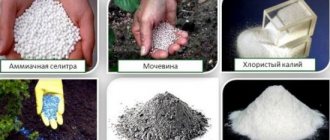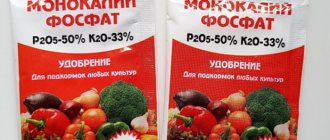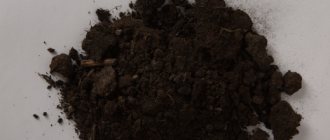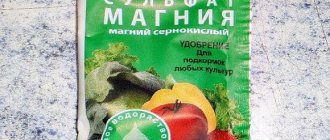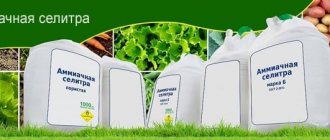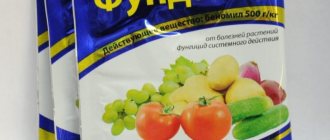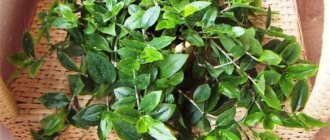Widely known organic fertilizers are manure and litter. But few people realize that potassium humate, a substance that has been used for more than half a century, is also of organic origin. It is recommended for improving soil, protecting plants and increasing the immunity of crops.
Humates are rightfully universal gardening products. The scope of application is wide: from the moment of processing the seed material to increasing the yield at the ripening stage.
Description, composition and mechanism of action of potassium humate
On sale you can find a variety of products called Potassium Humate. This does not mean that only one among the others is natural, and the rest are fake.
Differences in form and composition depend on the method of manufacturing the fertilizer: natural or artificial ingredients.
All types of humate (with microelements or dry, in tablet form) are substances with humic acids (over 81%).
The percentage of the remainder consists of amino acids, peptites, antibiotics and stimulants, enzymes. The ratio of additional substances differs between different manufacturers and release forms.
The mechanism of action is also not very different: stimulation of metabolic and biochemical processes. Obtaining fertilizer from coal and peat. In some cases from silt and certain types of soil.
The appearance of the fertilizer depends on the form:
- liquid - a natural substance obtained by processing peat;
- powder form - an artificially created drug;
- potassium humate with microelements: the second name is “Prompter”. It is a universal remedy. It is more used as a top dressing, which can be used every 2 weeks throughout the growing season. Then the application of humate Prompter is reduced to 1 time every 1.5 months. Obtained from bottom sediments of fresh water reservoirs (sapropel).
Interesting fact! Powdered fertilizer potassium humate can easily replace humus. If we carry out the ratios, we obtain the following data: 1 kg of humate will be equal to 1 ton of humus. At the same time, fertilizer in any form will help remove nitrates and toxic chemicals from the fruit.
What it is?
Due to the decomposition of organic residues, humus accumulates in the soil, its most nutritious component.
Only 10-15% of this substance contained in chernozems provides them with the greatest fertility among all soils. The organic part of humus consists of fulvic and humic acids.
The latter do not dissolve in water, therefore they are inaccessible to plant roots, but they form water-soluble humates - salts with potassium, ammonium or sodium.
Humates have a beneficial effect on the condition of plants and soil parameters. They have also found application in construction, medicine, livestock farming and other areas.
Now salts of humic acids are produced artificially, extracted from peat or brown coal under the influence of caustic soda under conditions of high temperature and pressure in autoclaves.
The resulting substance is separated from the solid residue and given the desired shape. Such humates are practically no different from those created by nature.
There are several similar drugs with different compositions.
Humate +7 contains organic sodium and potassium salts. The product is an improved version of Humate 80, in which 80% consists of humic salts.
Gumat +7 has added the seven most important microelements for plants, which we will talk about below.
Differences from sodium humate
There is not only potassium humate, but also sodium humate. Two different substances that are obtained by treating humic acids with alkali. Treatment of plants with these fertilizers is identical. The question then becomes what is the difference between the two.
The differences are in the receipt of batteries. If you feed with potassium humate, the crop will receive potassium. The element is necessary for the full development and ripening of fruits. The fertilizer is a potassium fertilizer.
Sodium humate is used when there is an excess of potassium. Top dressing has negative and positive qualities (immunomodulator, stimulator of maturation and growth). In addition to its beneficial effect on soil and plants, sodium prevents the supply and nutrition of potassium to crops. It also helps increase toxins.
Since the substance is cheaper than potassium humate, gardeners quite often buy it. Considering the pros and cons of the two fertilizers, before purchasing, you should think about the resulting harvest and the taste qualities of the fruit.
Compound
Depending on the raw materials used, the composition of the fertilizer can be different - organic or organomineral. Based on this factor, humates are divided into two types - potassium humate and sodium humate. Both drugs are similar in their characteristics. Let's take a closer look at how their composition differs.
Composition of potassium humate
Under the influence of this drug, the soil is saturated with useful elements that can improve the biological, chemical and physical parameters of the soil. Thanks to this, crop yields increase, their growth is stimulated and their quality improves.
This product belongs to organomineral fertilizers made from peat. In addition to the high content of potassium salts of humic acids, the composition of potassium humate is saturated with low molecular weight fulvic acids and amino acids. Also, the presence of active trace elements such as cobalt, copper, boron, molybdenum, zinc and manganese provides the drug with high value.
Potassium humate is characterized by neutral acidity and a wider sphere of action compared to sodium humate.
Composition of sodium humate
It is a powerful plant growth stimulator. Under its influence, the number of shoots increases, immune resistance to diseases and negative climatic factors (drought, high humidity, cold snaps) increases. The drug exhibits high adaptogenic and immunostimulating qualities.
Sodium humate is made from peat, less often from brown coal. The high pH content of humate makes it highly effective on alkaline soils. The drug prevents premature falling of leaves and ovaries. In plant growing, it is widely used in both liquid and dry form. The stimulant does not exhibit toxicity, it is not mutagenic and does not have cumulative properties.
The composition of sodium humate includes sodium salts of humic acids (70% of them in the substance). Microelements include molybdenum, copper, cobalt, manganese and zinc. Heavy metals include lead and cadmium. The dry composition contains nitrogen, phosphorus, potassium, magnesium, and calcium.
Types of fertilizer
Potassium humate is one of the universal fertilizers. At the same time, it is effective and economical to use. When compared with other popular organics (manure, humus), in addition to the positive effect on soil and plants, the following points are highlighted:
- environmentally friendly product;
- convenient for storage;
- quickly affects the culture;
- there is no need to wait until ready, as is the case with humus;
- does not have a sharp unpleasant odor.
Before feeding plants, it is worth deciding on the form of fertilizer. But the choice is made by the farmer himself. They take into account the degree of need, timing, how convenient the method of application is, goals, and expected results.
Liquid
Since the substance is obtained from peat, the color is dark brown. This form is the most popular. It is famous for its high efficiency and rapid action on seeds and seedlings. Potassium humate is a concentrated liquid that is diluted in cold water before use.
Bottles containing the substance contain instructions for dilution. Also, this form, unlike others, can be used together or sequentially with nitrogen-containing and organic fertilizers
Powder
It is more characterized by farmers as an immunomodulator. After treatment with dry potassium humate, the plant grows faster and bears fruit.
Positive changes occur in the soil (humus formation, acceleration of microflora restoration). Subject to breeding. The recipe and proportions for preparation are indicated on the packaging of the powder.
What are humates and what are their benefits?
During the decomposition of plant residues in the upper layers of the soil, humic acids are formed; their salts (sodium, potassium) are called humates. These natural compounds are necessary for soil microorganisms. By consuming them in the process of life, they change the mechanical and chemical composition of the soil for the better, making it more water-permeable and air-permeable.
The low humus content explains the low fertility of gray soils and soils of soddy-podzolic, podzolic type. Scientists have proven the positive effect of humic acids on soil composition (chemical, mechanical) and plant development. For amateur vegetable growers, there is a fertilizer on sale - humate (sodium, potassium), it is made from natural raw materials:
- sapropel;
- peat;
- coal (brown);
- lingnosulfates (secondary products obtained during the production of cellulose).
The production of two types of humic fertilizers has been launched: ballast-free and ballast. The first type is used in the form of fertilizing, the second type stimulates the growth of seedlings and strengthens the immunity of garden and vegetable crops. Release forms: granules, tablets, powder, gel, paste, liquid concentrate.
The beneficial properties of the drug are determined by the composition: 80% - humic acids, 20% - enzymes, growth activators, peptides, amino acids. Purpose of humic preparations:
- change for the better the characteristics of the soil, restoration of its fertility;
- increased activity of soil microorganisms;
- pH normalization;
- more efficient use of organic matter added to the soil;
- reduction of nitrogen fertilizer application rates by 50%;
- increasing the effectiveness of fungicides, insecticides, herbicides;
- positive effect on the appearance, taste of vegetables and fruits, maintaining their health and environmental cleanliness;
- formation of stress resistance (weather, infections) in all plant species;
- restoration, strengthening of the root system;
- soil improvement (removal of harmful impurities).
The use of humic products on a personal plot does not have a negative impact on humans, domestic animals, or the surrounding nature. These preparations are not inferior in effectiveness to mineral fertilizers, and are superior to them in terms of price and environmental friendliness.
Humic fertilizers can be combined with most mineral preparations (urea, ammonium nitrate, UAN-32). Gardeners note an increase in yields after the first year of their use. Fruits and vegetables collected from plants that receive this type of nutrition during the growing season retain their commercial quality and nutritional value longer.
Areas of use
Potassium humate is a universal organic product for application to plants. With its help, a gardener can begin working with soil and planting material.
During the growing season, feed the crop until harvest. Before winter, it is also added so that the soil replenishes the lost supply of useful microelements.
You can use humate:
- during preparatory work with seeds and seedlings. Application takes place in liquid form, i.e., soaking is carried out;
- as a top dressing;
- after transplanting seedlings for better adaptation and rooting;
- for treating plants in open and closed ground at all stages of growth;
- for spraying during the flowering period. But the concentration of the solution should be low (maximum 0.1%);
- to improve the quality of organic nitrogen-containing fertilizers and soil reclamation.
The method of preparation and dilution of the working solution is indicated on the packaging. Step-by-step instructions will help prevent possible side effects.
Pre-sowing preparation
Potassium humate is often used as an immunomodulator. To do this, the seed material is soaked before planting in the ground.
The procedure contributes to a percentage increase in the germination of seeds, bulbs, and grains. Use a liquid diluted concentrate. Soaking time from 8 hours to 24 hours.
Growing seedlings
To improve immunity, potassium humate is applied to seedlings. The fertilizer does not lose its properties, the effect manifests itself throughout the growing season.
When applied to seedlings, we get the following result:
- increased resistance to infections and fungi;
- pest resistance;
- increased survival after transplantation into open ground;
- stable condition under negative environmental influences.
As a fertilizer
You don’t have to wait until the seedlings are planted to start feeding them. Incorporating fertilizer into the soil for the winter or early spring will help perennial crops “wake up” and annual crops to take root faster. Dry humate is chosen as a “saving drug”.
For convenience, the powder is mixed with sifted river sand. Absorption into the middle and lower layers occurs during snow melting. If the winter has little snow, they dig.
Spraying and watering
This method is good because you don’t have to run around with a bucket among the beds, and the solution consumption is reduced. All you need to do is walk around the garden with a sprayer. In this case, no more than three grams of fertilizer is required per ten liters of water.
Important! Carefully filter the water, as it may contain many small particles of peat, which can immediately clog the spray nozzles of the same “Beetle”
As for watering, they are carried out three times with an interval of two weeks. The treatment period should coincide with the time of intensive growth. First, there should be at least half a liter of solution per plant, and then the volume is adjusted to a liter (for the third treatment).
For convenience, it is better to water the seedlings immediately after planting them in open ground, then repeat the treatment while setting buds, and water the plants a third time during their flowering. In this case, the concentration should be increased: a tablespoon of the substance is taken per bucket of water (ten liters). Here's how to use potassium humate.
Advantages and disadvantages
Definitely, the benefits of potassium humate cannot be exaggerated. The product has a stimulating effect for all types of garden crops. Its task is to have a beneficial effect on the roots of the plant, to force it to actively develop and strengthen.
Positive traits:
- suitable for all cultures;
- helps increase resistance to diseases, infections, pests;
- imparts frost resistance, increases the shelf life of the crop;
- reduces the need for nitrates in fruits;
- increased germination, accelerated fruiting time;
- ripening in general accelerates to 10-14 days;
- soil characteristics improve. There is an accelerated recovery of microelements;
- environmentally friendly fertilizer product.
There are only two negative aspects of the application. The first is that it cannot be applied if there is enough potassium in the soil. An excess of an element impairs the development of culture.
Secondly, strict adherence to dosages is required. Not a single organic product in concentrated form can have a beneficial effect on the earth and the plant.
Where is it used?
The drug is used for fertilizing and restoring soil fertility. The fertilizer is suitable for all garden, garden and ornamental crops, including seedlings.
Humate +7 is also used for soaking planting material (seeds, bulbs, roots of seedlings).
As a top dressing, the product is effective for solving a number of problems:
- stimulation of growth processes;
- enhancing vitality, including frost resistance, in perennials;
- increasing seed germination and survival rate of seedlings;
- nutrition with microelements.
Humate +7 is suitable for correcting depleted soils with a low proportion of humus, especially alkaline soils containing little iron, since it increases acidity.
But the drug is also useful for acidic soils if they are alkalized with lime, dolomite flour or chalk.
Substances used for liming inhibit soil microflora, while humate stimulates the development of beneficial bacteria.
For the same purpose, the product is applied to soil treated with chemical pesticides.
How to prepare a working mixture
In 90% of cases, it is recommended to dilute potassium humate before use. A concentrated liquid product does harm instead of benefit. Instructions from the manufacturer provide for different dosages for dilution.
Depends on the type of crop, the need for the element, the condition of the soil, and the stage of development. If the solution is needed for soaking seeds, then stirring 0.5 g in a liter of water is enough. Processing times vary from 8 to 48 hours.
Watering/spraying also takes place according to different schemes. To apply under the root, the ratio of substances is 1 tbsp. l. to 10 liters (potassium humate is stirred in water). Spraying: a less concentrated solution is required (3 g of fertilizer per 10-liter bucket).
Liquid organic fertilizer is often recommended for treating fruits after spraying with pesticides. This is how detoxification is carried out. Ratio: 50 g powder + 50 g sand. The consumption of the received funds is 10 square meters. m.
Need to know! In addition to powder, tablets and concentrate, you can buy potassium humate in the form of a gel/paste. The drug is more expensive than others, but more effective. The composition contains the most active molecules, which ensures an increase in the percentage of penetration.
In what form can humates be used?
Humates are sold in dry form (powders) and liquid. Use the option that is more convenient for you. Dilute according to the instructions on the package, dosages depend on the specific manufacturer.
Humic preparations can:
Carry out foliar feeding.
This is very useful for the development of plant leaf mass and activation of photosynthesis processes.
Incorporation of dry preparation into the soil
Apply humates during autumn digging or in spring, a week or two before planting.
Soaking the seeds
Pre-sowing seed treatment promotes better germination, accelerates germination and reduces the likelihood of seedlings dying from blackleg.
As a rule: 0.5 grams of humic powder per 1 liter of water.
Processed Zucchini Seeds
Instructions for use of the prepared solution
Potassium humate, regardless of purpose, must be diluted according to the manufacturer's instructions. Recommendations apply separately to crops and species.
For cereals
The farmer himself must choose the method of application for grain crops. A liquid concentrate is recommended for processing seed material and spraying. For effective use, it is suggested to dilute 200 ml of potassium humate in 10 liters of water.
Application depends on the growing season:
- first leaves, flowering - corn;
- budding, then after 2-3 weeks repeat the procedure - buckwheat;
- tillering, first inflorescences – sorghum, millet, oats, barley, rye, wheat
For vegetables
In this case, fertilizing (foliar, under the root) should take into account the type of crop:
- for cucumbers and tomatoes, the solution is standard (dilute 100 ml of potassium humate in 10 liters of water). Number of applications/treatments – up to 4 times;
- leafy for all vegetables (including tomatoes) 50 ml per 10 l. Consumption depends on the age of the seedling (per 1 sq. m. from 3 to 10 l);
- carrots, zucchini, cabbage and beets are treated 4 times per season with a standard solution.
How to improve efficiency?
The experience of recent years has shown that it is more effective to use humates not as fertilizers, but as a complex action product. And timely stress relief further enhances the effect of feeding. If you rely on relieving stress and stimulating growth, then you should take advantage of all the possibilities available to science. Stress results in stunted growth. Therefore, the task is somewhat simplified. It all comes down to driving growth. Farmers know that phytohormones best stimulate growth. The main thing is to choose the right combination and provide the plant with nutrition. If the plant does not have the resources necessary for growth, treatment with phytohormones will not lead to anything good. The Normat L preparation contains humic and fulvic acids and other important substances - that is, a comprehensive set of nutrients (including microelements), and in an easily digestible form. And this healthy “cocktail” is complemented by microdoses of phytohormones. If Normat L is used together, for example, with pesticides, then at the first moment phytohormones help the plant continue to grow. They act quickly. Then humic substances are added to them. They are also quickly absorbed and help the plant recover from stress. After some time, growth again occurs due to its own phytohormones, and the beneficial substances introduced by Normat L help maintain this growth. Likewise, the phytohormones in Normat C help awaken the seeds. Soaking in a Normat C solution not only “awakens the seeds” and increases germination, but also provides them with a set of nutrients “for the first time”
Is it really so important that the seeds will sprout, as if on command, earlier than usual, and the sprouts of cultivated plants will appear from the ground before the weeds? Is it really so important that they will have more developed roots and, accordingly, increased resistance to frost and drought? Decide for yourself...
Fertilizer compatibility
At the beginning of the season, the farmer creates his own calendar of treatments and field work with plants. At the same time, treatments with fertilizers, fungicides and other means are taken into account. If you decide to use potassium humate during the growing season, it means:
- Do not treat the soil together with phosphorus-containing preparations or potassium nitrate. The gap between applications can be at least a week.
- Perennial crops are processed several times per season. But annual plants - only before budding.
Beneficial properties for soil
The use of humic preparations, according to foreign and domestic scientists, is expressed in the following:
- Increases seed germination and germination up to 100%;
- Stimulates root nutrition as a result of building up the root system;
- Helps the plant to absorb those beneficial substances and microelements contained in the soil, converting them into an assimilable form;
- The microbiological structure of the soil improves;
- Humates are responsible for structuring the soil, turning very small soil particles into larger lumps. The soil becomes looser and more moisture-absorbing, and significantly more so;
- Due to the looseness of the soil, the roots absorb more oxygen from the soil;
- Heavy metal salts are bound into compounds that are inaccessible for absorption by plants.
Analogues of potassium humate
It is not necessary to purchase potassium humate. You can always use similar products that contain mineral supplements. “Humate + 7 iodine” has proven itself well. Also offer:
- Gibbersib is a phytohormonal substance;
- Hyteroauxin – growth activator;
- Athlete – growth regulator;
- Gumifield is a stimulant.
Each drug has beneficial properties and special rules for use. Before starting work, be sure to study the instructions for use, dosage and expiration dates.
Mistake #2: watering with humate too often
This happens because of error No. 1. We decide that humate is a natural fertilizer and water our plants with it almost every week. Meanwhile, these preparations, being salts, make the soil acidic when applied frequently, while almost all vegetables love a neutral environment. Under conditions of high acidity, minerals necessary for plant nutrition form insoluble compounds that are not available for absorption by the roots. “Green pets” are left without food and, contrary to our expectations, instead of growing rapidly, they begin to starve and waste away.
